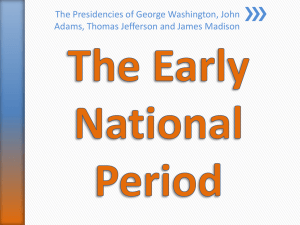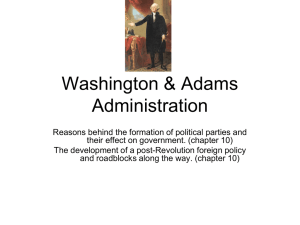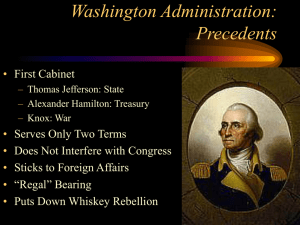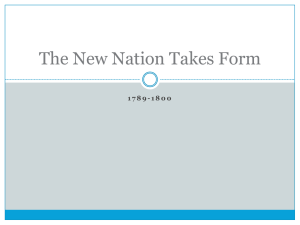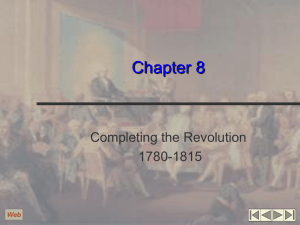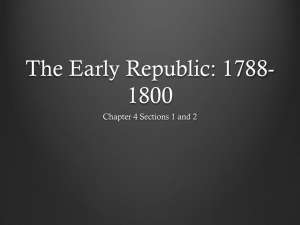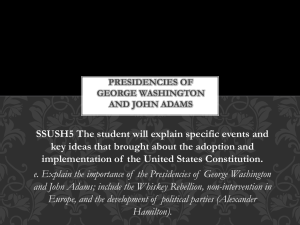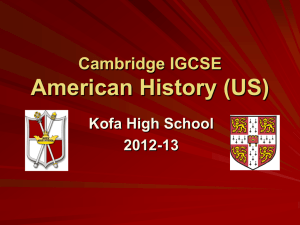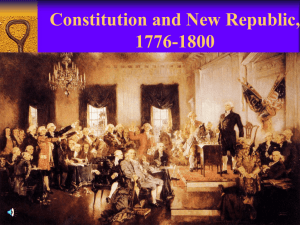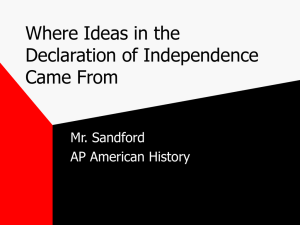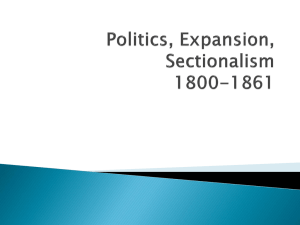The Federalist Era 1789
advertisement
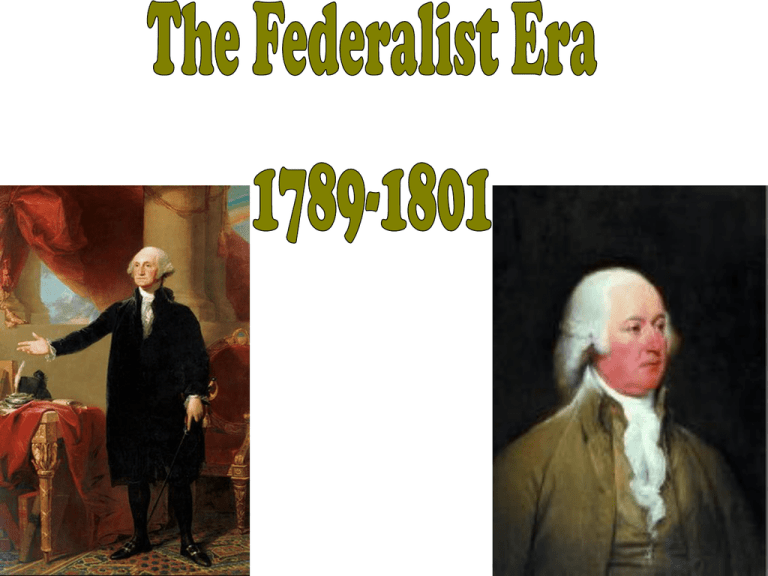
Bill of Rights • The first amendments (add-ons) to the Constitution • 1st priority of the new Congress • Anti-Federalists had demanded these additions • James Madison wrote & proposed 12 • 10 ratified and added in 1791 •Amendment 10 was that guarantee the basic rights of the most important to the people the Anti-Federalists Judiciary Act of 1789 • Written to organize the • Created the office of the Judicial Branch of the United Attorney General States John Jay – 1st Chief Justice • Article III was left very short on purpose • Organized the Supreme Court to have 6 Justices • Also organized Federal District & Circuit Courts Revenue Act of 1789 • The U.S. had a lot of debt • Congress decided to pay it off through the use of tariffs • Set the 1st national tariff at 8% to earn a revenue for the national government The State Department • Congress also needed to deal with problems with foreign nations – Britain, Spain, & France • Established the State Department to deal with them • 1st Federal Agency established • Thomas Jefferson was the 1st Secretary of State Mr. President • Elected Unanimously • President from 1789 – 1797 – 3 new States will enter the Union – VT (1791), KY (1792), & TN (1796) • Took oath of office on April 30, 1789 in NYC • John Adams would be the VP Establishment of the Cabinet • Washington knew he was not the most brilliant man • Appointed men with expertise in areas to become part of the cabinet • Would advise Washington • Set precedent that each President would have a cabinet, but is not part of the Constitution Secretary of State -- Thomas Jefferson Secretary of the Treasury -- Alexander Hamilton Secretary of War -- Henry Knox Attorney General --Edmund Randolph Political Parties • No political parties existed within the U.S. until Washington’s Presidency • Disagreements over the interpretation of the Constitution & the power of the national government would lead to political parties • Since then, the U.S. has been dominated by two party system • But the two parties have not been the same two parties since Washington’s administration Federalists • Led by Alexander Hamilton • Wanted a fiscally sound and strong nationalistic government • Had a strong following in the North Democratic-Republicans • Led by Thomas Jefferson • Sometimes referred to as the Jeffersonian-Republicans • Opposed a strong national government & Hamilton’s financial plans Interpretation of the Constitution • Loose v. Strict – Federalists wanted a loose interpretation of the Constitution – you can read between the lines – D-R wanted a strict interpretation – what it says is what it mean – it is not open to interpretation • The Elastic Clause – Article 1, Section8, Clause 18 – Gave Congress the “Necessary & Proper” power to pass laws – Federalists would use this to support their loose interpretation of the Constitution Dealing with the DEBT • Report on the Public Credit (1790) plan given to Congress to fix the debt • National government would assume all state debts • Opposed by the D-Rs • Created a huge debate throughout the nation • Eventually led to a compromise: – Government would assume debt – South would get Washington D.C. as the capital Battle for a National Bank (1790-1791) • Hamilton also wanted to create a national bank to handle the monetary needs of the country • Problem: Government not given this authority in the Constitution • Hamilton used the Elastic Clause to support his views • Jefferson strongly opposed • Washington approved and the Bank was created in 1791 with a 20 year charter Excise Taxes • Hamilton’s main way to raise revenue was through tariffs but also wanted excise taxes • Excise Tax: taxes placed on specific goods produced within a country • In 1791 several excise taxes created – Most notably on Whiskey The Whiskey Rebellion (Pennsylvania 1794) • Backcountry PA distillers hit hard by 7¢/gallon tax • Whiskey was used as money • “Whiskey Boys” began to harass tax collectors • By 1794 talks of secession had begun • Aug 1794, Washington led the army to put the Rebellion down • Domestic tranquility was ensured The French Revolution • Country split on how to feel about this Revolution • D-Rs: pleased – Saw it as an extension of the American Revolution • Federalists: worried – Saw mass hysteria and mob violence as a threat to themselves The Problem for the U.S. • In 1793, it became a world war being fought between ALL of the major European powers – most importantly Britain who was the main trading partner of the U.S. • U.S. still obligated to France because of the FrancoAmerican Alliance of 1778 • D-Rs favored honoring the alliance • Federalists supported Britain Washington’s Neutrality Proclamation (1793) • Washington believed the country is not militarily prepared to fight another war • Issued the Neutrality Proclamation saying the U.S. would not choose sides, but would stay out of it • U.S. still traded with both sides Jay’s Treaty (1794) • Britain still occupies forts in Northwest Territory & menacing U.S. in the Caribbean • John Jay sent to London to create a treaty to ease tensions • Terms: 1. Britain agrees to leave the forts 2. Britain agrees to pay damages to American ships in the Caribbean 3. Britain refuses to agree to stop harassing the U.S. 4. The U.S. must pay all debts still owed to Britain Pinckney’s Treaty (1795) • Dealt with Spain • Terms: 1. Established a boundary between the U.S. & Spanish Florida 2. Allowed the U.S. free navigation rights of the Mississippi River 3. Allowed the U.S. the use of the port of New Orleans His Farewell Address (1796) • After 2 terms Washington refused a third term • Wrote a letter to the American public to say goodbye • 2 important ideas included: 1. End Partisanship – there should be NO political parties 2. Warned against permanent foreign alliances Washington’s Precedents 1. Have Advisors & form a Cabinet 2. Executive can choose his own Cabinet 3. Two-term Limit for Presidents - not broken until FDR in 1940 4. No permanent alliances - 1949 NATO Adams v. Jefferson • D-R Candidate was Thomas Jefferson • Federalist Candidate was John Adams The Decision • Adams won 71-68 in the Electoral College • Because only one ballot was cast, whoever was in 2nd place became VP • Jefferson ended up as VP Mr. Adams as President • Served only 1 term from 1797-1801 • Followed precedents set by Washington Relations with France • France very upset about Jay’s Treaty – Saw it as a precursor to an alliance with Britain • France wanted the U.S. to honor the FrancoAmerican Alliance of 1778 • France began to attack U.S. ships and seizing American cargo • 300 ships and $20 million of cargo was lost XYZ Affair (1797) • Delegation sent to France to meet with French Foreign Minister Charles Talleyrand • Three French delegates X,Y, & Z demanded $12 million loan & a cash bribe just for a meeting • Americans insulted & came home • Report published & started AntiFrench sentiment at home Quasi-War (1798-1800) • U.S. began an undeclared war against France • Was purely navel – fought mainly in the Caribbean • Adams had to quickly expand the 3 ship navy & an army of 10,000 men was authorized Convention of 1800 • France did not want another enemy • Napoleon now in charge – Forced Talleyrand to try to create a treaty with the U.S. • Adams sent a delegation and a treaty was signed • Terms: – Ended Franco-American Alliance – All ships seized by both sides would be returned Alien and Sedition Acts (1798) • Purpose: Silence & reduce opposition from the D-Rs about the Quasi War with France • Alien Acts: raised residence requirements for citizenship from 5 to 14 years – Most immigrants were D-Rs • Sedition Act: it was a crime to publish “false, scandalous, and malicious writing” about the government or its officials – Direct violation of the 1st Amendment • Laws expired in 1801 Virginia and Kentucky Resolutions (1798) • D-Rs convinced the Acts were unconstitutional • Problem: Who decides the Constitutionality of laws? • Jefferson & Madison anonymously write the VA & KY Resolutions • Premise: States had the right to nullify unconstitutional laws passed by Congress • Importance: Southerners later used this argument to support secession from the Union Adams v. Jefferson • D-R Candidate was Thomas Jefferson • Federalist Candidate was John Adams The Decision • Adams lost – Federalists angry about Convention of 1800 – Unpopular Alien & Sedition Acts – Debt increased • Problem: Jefferson tied with Aaron Burr • House of Reps had to break the tie • Hamilton persuaded Federalists to back Jefferson The Revolution of 1800 • Peaceful transition of power between two political parties The Federalists Legacy 1. Built enduring political and financial foundations for the new government 2. Diplomats kept the U.S. out of war and signed advantageous treaties with Br, Fr, & Sp. 3. Preserved democratic gains of the Revolution 4. Opposition resulted in creation of two-party system
